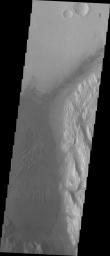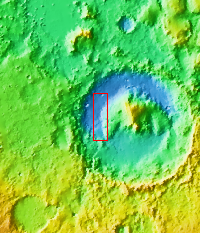
|
Images of Gale #20
- Click the image above for a larger view
- Full-Res JPEG (1395 x 3234) (237.1 kB)
- Full-Res TIFF (1395 x 3234) (4.5 MB)
Caption:
During the month of April Mars will be in conjunction relative to the Earth. This means the Sun is in the line-of-sight between Earth and Mars, and communication between the two planets is almost impossible. For conjunction, the rovers and orbiting spacecraft at Mars continue to operate, but do not send the data to Earth. This recorded data will be sent to Earth when Mars moves away from the sun and the line-of-sight between Earth and Mars is reestablished. During conjunction the THEMIS image of the day will be a visual tour of Gale Crater, the location of the newest rover Curiosity.
Showing the area just slightly west of the previous image, the large region of sand and sand dunes are the dark area that dominates this image.
Orbit Number: 5963 Latitude: -5.04024 Longitude: 137.098 Instrument: VIS Captured: 2003-04-19 09:41
Background Info:
Please see the THEMIS Data Citation Note for details on crediting THEMIS images.
NASA's Jet Propulsion Laboratory manages the 2001 Mars Odyssey mission for NASA's Science Mission Directorate, Washington, D.C. The Thermal Emission Imaging System (THEMIS) was developed by Arizona State University, Tempe, in collaboration with Raytheon Santa Barbara Remote Sensing. The THEMIS investigation is led by Dr. Philip Christensen at Arizona State University. Lockheed Martin Astronautics, Denver, is the prime contractor for the Odyssey project, and developed and built the orbiter. Mission operations are conducted jointly from Lockheed Martin and from JPL, a division of the California Institute of Technology in Pasadena.
Cataloging Keywords:
| Name | Value | Additional Values |
|---|---|---|
| Target | Mars | |
| System | ||
| Target Type | Planet | |
| Mission | 2001 Mars Odyssey | Mars Science Laboratory (MSL) |
| Instrument Host | Mars Odyssey | Curiosity Rover |
| Host Type | Orbiter | Rover |
| Instrument | Thermal Emission Imaging System (THEMIS) | |
| Detector | ||
| Extra Keywords | Crater, Dune, Grayscale, Thermal | |
| Acquisition Date | ||
| Release Date | 2013-04-30 | |
| Date in Caption | 2003-04-19 | |
| Image Credit | NASA/JPL-Caltech/ASU | |
| Source | photojournal.jpl.nasa.gov/catalog/PIA16972 | |
| Identifier | PIA16972 | |

